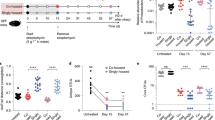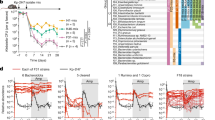Abstract
Mammals harbour a complex gut microbiome, comprising bacteria that confer immunological, metabolic and neurological benefits1. Despite advances in sequence-based microbial profiling and myriad studies defining microbiome composition during health and disease, little is known about the molecular processes used by symbiotic bacteria to stably colonize the gastrointestinal tract. We sought to define how mammals assemble and maintain the Bacteroides, one of the most numerically prominent genera of the human microbiome. Here we find that, whereas the gut normally contains hundreds of bacterial species2,3, germ-free mice mono-associated with a single Bacteroides species are resistant to colonization by the same, but not different, species. To identify bacterial mechanisms for species-specific saturable colonization, we devised an in vivo genetic screen and discovered a unique class of polysaccharide utilization loci that is conserved among intestinal Bacteroides. We named this genetic locus the commensal colonization factors (ccf). Deletion of the ccf genes in the model symbiont, Bacteroides fragilis, results in colonization defects in mice and reduced horizontal transmission. The ccf genes of B. fragilis are upregulated during gut colonization, preferentially at the colonic surface. When we visualize microbial biogeography within the colon, B. fragilis penetrates the colonic mucus and resides deep within crypt channels, whereas ccf mutants are defective in crypt association. Notably, the CCF system is required for B. fragilis colonization following microbiome disruption with Citrobacter rodentium infection or antibiotic treatment, suggesting that the niche within colonic crypts represents a reservoir for bacteria to maintain long-term colonization. These findings reveal that intestinal Bacteroides have evolved species-specific physical interactions with the host that mediate stable and resilient gut colonization, and the CCF system represents a novel molecular mechanism for symbiosis.
This is a preview of subscription content, access via your institution
Access options
Subscribe to this journal
Receive 51 print issues and online access
$199.00 per year
only $3.90 per issue
Buy this article
- Purchase on SpringerLink
- Instant access to full article PDF
Prices may be subject to local taxes which are calculated during checkout



Similar content being viewed by others
References
McFall-Ngai, M. et al. Animals in a bacterial world, a new imperative for the life sciences. Proc. Natl Acad. Sci. USA 110, 3229–3236 (2013)
The Human Microbiome Project Consortium. Structure, function and diversity of the healthy human microbiome. Nature 486, 207–214 (2012)
Yatsunenko, T. et al. Human gut microbiome viewed across age and geography. Nature 486, 222–227 (2012)
Qin, J. et al. A human gut microbial gene catalogue established by metagenomic sequencing. Nature 464, 59–65 (2010)
Palmer, C., Bik, E. M., Digiulio, D. B., Relman, D. A. & Brown, P. O. Development of the human infant intestinal microbiota. PLoS Biol. 5, e177 (2007)
Dethlefsen, L., Huse, S., Sogin, M. L. & Relman, D. A. The pervasive effects of an antibiotic on the human gut microbiota, as revealed by deep 16S rRNA sequencing. PLoS Biol. 6, e280 (2008)
Eckburg, P. B. et al. Diversity of the human intestinal microbial flora. Science 308, 1635–1638 (2005)
Bry, L., Falk, P. G., Midtvedt, T. & Gordon, J. I. A model of host-microbial interactions in an open mammalian ecosystem. Science 273, 1380–1383 (1996)
Xu, J. et al. A genomic view of the human-Bacteroides thetaiotaomicron symbiosis. Science 299, 2074–2076 (2003)
Mazmanian, S. K., Liu, C. H., Tzianabos, A. O. & Kasper, D. L. An immunomodulatory molecule of symbiotic bacteria directs maturation of the host immune system. Cell 122, 107–118 (2005)
Mazmanian, S. K., Round, J. L. & Kasper, D. L. A microbial symbiosis factor prevents intestinal inflammatory disease. Nature 453, 620–625 (2008)
Round, J. L. & Mazmanian, S. K. Inducible Foxp3+ regulatory T-cell development by a commensal bacterium of the intestinal microbiota. Proc. Natl Acad. Sci. USA 107, 12204–12209 (2010)
Ochoa-Repáraz, J. et al. Central nervous system demyelinating disease protection by the human commensal Bacteroides fragilis depends on polysaccharide A expression. J. Immunol. 185, 4101–4108 (2010)
Ley, R. E., Peterson, D. A. & Gordon, J. I. Ecological and evolutionary forces shaping microbial diversity in the human intestine. Cell 124, 837–848 (2006)
Koropatkin, N. M., Cameron, E. A. & Martens, E. C. How glycan metabolism shapes the human gut microbiota. Nature Rev. Microbiol. 10, 323–335 (2012)
Martens, E. C., Koropatkin, N. M., Smith, T. J. & Gordon, J. I. Complex glycan catabolism by the human gut microbiota: the Bacteroidetes Sus-like paradigm. J. Biol. Chem. 284, 24673–24677 (2009)
Shipman, J. A., Berleman, J. E. & Salyers, A. A. Characterization of four outer membrane proteins involved in binding starch to the cell surface of Bacteroides thetaiotaomicron. J. Bacteriol. 182, 5365–5372 (2000)
Schauer, K., Rodionov, D. A. & de Reuse, H. New substrates for TonB-dependent transport: do we only see the ‘tip of the iceberg’? Trends. Biochem. Sci. 33, 330–338 (2008)
Kawada, M. et al. Chitinase 3-like-1 enhances bacterial adhesion to colonic epithelial cells through the interaction with bacterial chitin-binding protein. Lab. Invest. 88, 883–895 (2008)
Martens, E. C., Chiang, H. C. & Gordon, J. I. Mucosal glycan foraging enhances fitness and transmission of a saccharolytic human gut bacterial symbiont. Cell Host Microbe 4, 447–457 (2008)
Sonnenburg, J. L. et al. Glycan foraging in vivo by an intestine-adapted bacterial symbiont. Science 307, 1955–1959 (2005)
Round, J. L. et al. The Toll-like receptor 2 pathway establishes colonization by a commensal of the human microbiota. Science 332, 974–977 (2011)
Pédron, T. et al. A crypt-specific core microbiota resides in the mouse colon. MBio 3, e00116–12 (2012)
Mundy, R., MacDonald, T. T., Dougan, G., Frankel, G. & Wiles, S. Citrobacter rodentium of mice and man. Cell. Microbiol. 7, 1697–1706 (2005)
Bloom, S. M. et al. Commensal Bacteroides species induce colitis in host-genotype-specific fashion in a mouse model of inflammatory bowel disease. Cell Host Microbe 9, 390–403 (2011)
Freter, R., Brickner, H., Botney, M., Cleven, D. & Aranki, A. Mechanisms that control bacterial populations in continuous-flow culture models of mouse large intestinal flora. Infect. Immun. 39, 676–685 (1983)
Wurch, T., Lestienne, F. & Pauwels, P. J. A modified overlap extension PCR method to create chimeric genes in the absence of restriction enzymes. Biotechnol. Tech. 12, 653–657 (1998)
Acknowledgements
We thank T. Thron and S. McBride for the maintenance of germ-free animals, J. Selicha for assisting with the experimental procedures and G. Chodaczek for help with confocal and two-photon microscopy. We are grateful to E. C. Martens and members of the Mazmanian laboratory for critical review of the manuscript. S.M.L. and G.P.D. were supported by a pre-doctoral training grant (GM007616). This work was supported by grants from the National Institutes of Health (GM099535 and DK078938) and the Crohn’s and Colitis Foundation of America to S.K.M.
Author information
Authors and Affiliations
Contributions
S.M.L. and S.K.M. conceived the project. S.M.L. performed most of the experiments; G.P.D., Z.M. and S.B. contributed data. S.M.L., G.P.D., Z.M., K.L. and S.K.M. interpreted the data. K.L. and S.K.M. secured funding. S.M.L. and S.K.M. wrote the manuscript. G.P.D., Z.M. and K.L. edited the manuscript.
Corresponding author
Ethics declarations
Competing interests
The authors declare no competing financial interests.
Supplementary information
Supplementary Information
This file contains Supplementary Figures 1-13, Supplementary Equation 1, Supplementary References and Supplementary Tables 1-2. (PDF 10885 kb)
Wild-type B. fragilis within the central channel of colonic crypt
Travel through a confocal Z stack from the apical portion of the colonic mucosa down the length of the crypt of a B. fragilis mono-colonized mouse. F-actin is visualized with fluorescently labeled phalloidin (Alexa Fluor 546) to distinguish cell boundaries and crypt structures (green). Cell nuclei are stained with DAPI (blue). Bacteria are detected using chicken antibody directed to B. fragilis and Alexa Fluor 488-conjugated anti-chicken secondary antibody (red). Note the presence of a central channel that is bifurcating in the lower portion of the stack in the three-dimensional visualization of F-actin morphology using iso-surface rendering. Bacteria are found near the apical part of the epithelium and in the crypt space. (MOV 3036 kb)
Rights and permissions
About this article
Cite this article
Lee, S., Donaldson, G., Mikulski, Z. et al. Bacterial colonization factors control specificity and stability of the gut microbiota. Nature 501, 426–429 (2013). https://doi.org/10.1038/nature12447
Received:
Accepted:
Published:
Issue Date:
DOI: https://doi.org/10.1038/nature12447
This article is cited by
-
Unlocking the secrets: exploring the influence of the aryl hydrocarbon receptor and microbiome on cancer development
Cellular & Molecular Biology Letters (2024)
-
Assessing microbiome population dynamics using wild-type isogenic standardized hybrid (WISH)-tags
Nature Microbiology (2024)
-
Bacteroides fragilis toxin expression enables lamina propria niche acquisition in the developing mouse gut
Nature Microbiology (2024)
-
A host–microbiota interactome reveals extensive transkingdom connectivity
Nature (2024)
-
Emerging tools for uncovering genetic and transcriptomic heterogeneities in bacteria
Biophysical Reviews (2024)




